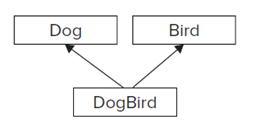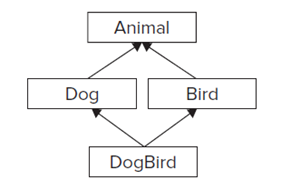多重继承常常被认为是 OOP 中一种复杂且不必要的部分。多重继承面临 crash 的场景并非难以想象,来看下面的例子。
1. 名称冲突
来看以下情况:
如果 Dog 类以及 Bird 类都有一个名为 eat() 的方法,而子类又没有 override 该方法。如果此时调用子类的 eat() 方法,编译器就会报错,指出 eat() 的调用有歧义(不知道是调用从 Dog 类继承而来的 eat() 方法,还是从 Bird 类继承而来的 eat() 方法)。代码如下:
class Dog { public: virtual void eat() {}; }; class Bird { public: virtual void eat() {}; }; class DogBird : public Dog, public Bird { }; int main() { DogBird db; db.eat(); // BUG! Ambiguous call to method eat() return 0; } /* 编译错误: [purple@archlinux AAA]$ clang++ aa.cc aa.cc:21:8: error: member 'eat' found in multiple base classes of different types db.eat(); // BUG! Ambiguous call to method eat() ^ aa.cc:4:18: note: member found by ambiguous name lookup virtual void eat() {}; ^ aa.cc:10:18: note: member found by ambiguous name lookup virtual void eat() {}; ^ 1 error generated. */
解决方法:
#include <iostream> using namespace std; class Dog { public: virtual void eat() {cout << "The Dog has eaten." << endl;}; }; class Bird { public: virtual void eat() {cout << "The Bird has eaten." << endl;}; }; class DogBird : public Dog, public Bird { }; int main() { DogBird db; static_cast<Dog>(db).eat(); // Slices, calling Dog::eat() db.Bird::eat(); // Calls Bird::eat() return 0; } /* Output: The Dog has eaten. The Bird has eaten. */
2. 歧义基类
来看以下情况:
虽然可能产生 name ambiguity,但是 C++ 允许这种类型的类层次结构。例如,如果 Animal 类有一个 public 方法 sleep(),那么 DogBird 对象将无法调用这个方法,因为编译器不知道调用 Dog 继承的版本还是 Bird 继承的版本。代码如下:
class Animal { public: void sleep(){} }; class Dog : public Animal { }; class Bird : public Animal { }; class DogBird : public Dog, public Bird { }; int main() { DogBird db; db.sleep(); return 0; } /* 发生编译错误 [purple@archlinux ~]$ clang++ aa.cc aa.cc:25:8: error: non-static member 'sleep' found in multiple base-class subobjects of type 'Animal': class DogBird -> class Dog -> class Animal class DogBird -> class Bird -> class Animal db.sleep(); ^ aa.cc:7:10: note: member found by ambiguous name lookup void sleep(){} ^ 1 error generated. */
使用“菱形”类层次结构的最佳方法是将最顶部的类设置为抽象类,所有方法都设置为纯虚方法。由于类只声明方法而不提供定义,在基类中没有方法可以调用,因此在这个层次上就不会产生歧义。代码如下:
#include <iostream> using namespace std; class Animal { public: virtual void sleep() = 0; }; class Dog : public Animal { public: virtual void sleep() { cout << "Dog sleep!" << endl; } }; class Bird : public Animal { public: virtual void sleep() { cout << "Bird sleep!" << endl; } }; class DogBird : public Dog, public Bird { public: // 注意:虽然从语法上来说,DogBird可以不override sleep方法 // 但是如此一来,再调用DogBird类的sleep方法时,会分不清是Dog类的还是Bird类的 virtual void sleep() { cout << "DogBird sleep!" << endl; } }; int main() { DogBird db; db.sleep(); return 0; } /* Output: DogBird sleep! */
小结
我们往往会在定义一个“既是一个事物同时又是另外一个事物”的情况下使用多重继承,然而,实际上遵循这个模式的实际对象很难恰如其分的转换为合适的代码,因此在工程中,我们要尽量避免使用多重继承。

